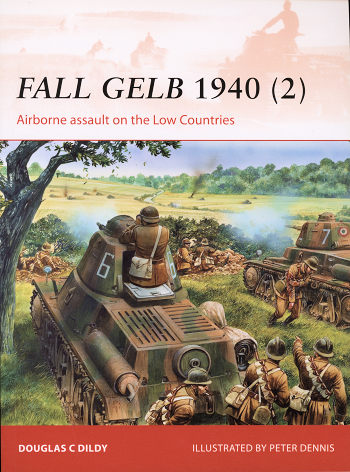 I'm a
bit late on reviewing this one (as in several years) as I found it behind a
dresser after moving it to look for something else. However, it is still fairly
available so here it goes.
I'm a
bit late on reviewing this one (as in several years) as I found it behind a
dresser after moving it to look for something else. However, it is still fairly
available so here it goes. |
Author: |
Douglas Dildy illustrated by Peter Dennis |
|
Publisher/Distributor |
Osprey Publishing |
|
Price |
$24.00 MSRP |
|
Reviewer: |
|
| Notes: |
96 pages, 7¼ x 9¼ inches, softcover ISBN: 978-1-4728-0274-3 |
 I'm a
bit late on reviewing this one (as in several years) as I found it behind a
dresser after moving it to look for something else. However, it is still fairly
available so here it goes.
I'm a
bit late on reviewing this one (as in several years) as I found it behind a
dresser after moving it to look for something else. However, it is still fairly
available so here it goes.
This is the second volume on the German invasion of western Europe in 1940 and concentrates on the use of airborne units in Belgium and the Netherlands.
This was a fairly audacious plan and required a lot of things to go the way of the invading armies to make things work as they should. Those who follow military histories will not be surprised that it was a far closer thing than one would have initially thought and one of the several reasons it was successful was due to the near total superiority of the airspace above these nations by the Luftwaffe.
Both the Dutch and Belgians had small air forces that simply were not capable of handling the larger and more experienced Luftwaffe. Though they put up a brave defense initially, they were quickly overwhelmed. Much the same can be said of their armies, though they were more successful in slowing and in some cases, halting the advances.
The German plan was to use its considerable offensive bombing and transport capabilities to first destroy what defensive units it could by bombing and then to land airborne troops at various air fields. It was hoped that air field defenses would have been destroyed prior to this, but that was not the case. It was also not helpful that many of the landing fields were soggy from recent heavy rains and many German Ju-52s ended up crashing upon landing. This did nothing to assist in the concentration of German troop who still had to take care of the Dutch and Belgian defenses. Despite some assistance from French and British forces, they were really too few and a bit too late to make much of a difference in the outcome.
What makes this book so interesting is to watch how the various battles unfold. To see that indeed, the defenders were not as helpless as some histories intimate and that in several instances it was a very close thing, especially in regards to the lightly armed airborne troops. As usual with this series, you get a look at what lead up to this campaign. This includes the commanders involved and both the offensive and defensive plans. We see how well trained and equipped the two sides were and then the flow of the campaign itself. This is further enhanced by superb period photos and the great illustrations of Peter Dennis. I find that the various maps provided are really key to understanding how the campaign progresses.
In all, it makes for another superb title in this, Osprey's longest running series of books.
January 2019
Copyright ModelingMadness.com. All rights reserved.
For more on the complete line of Osprey books, visit www.ospreypublishing.com .
If you would like your product reviewed fairly and quickly, please contact me or see other details in the Note to Contributors.